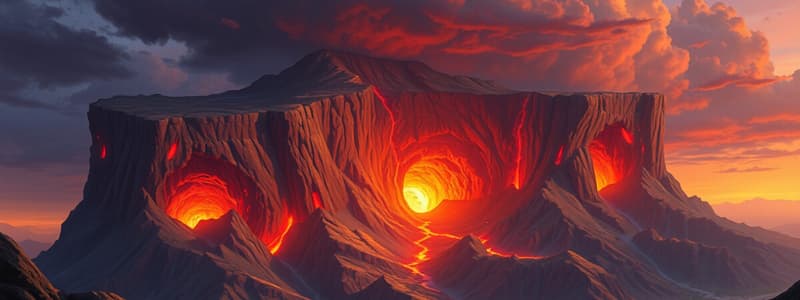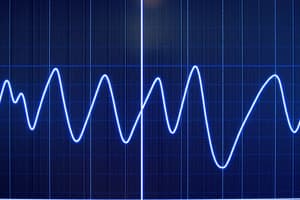Podcast
Questions and Answers
What is an earthquake?
What is an earthquake?
The vibration of Earth produced by the rapid release of energy.
What is a foreshock?
What is a foreshock?
A small burst of shaking that occurs before a large earthquake.
What is the main shock?
What is the main shock?
The strongest and usually first shock.
What is an aftershock?
What is an aftershock?
What causes earthquakes and where do they happen?
What causes earthquakes and where do they happen?
Why does the Earth shake when there is an earthquake?
Why does the Earth shake when there is an earthquake?
How do scientists measure the size of earthquakes?
How do scientists measure the size of earthquakes?
What are P waves?
What are P waves?
What are S waves?
What are S waves?
Can scientists predict earthquakes?
Can scientists predict earthquakes?
How deep was the earthquake that struck Taiwan on December 1, 2008?
How deep was the earthquake that struck Taiwan on December 1, 2008?
When was the most recent, worst earthquake to strike Taiwan?
When was the most recent, worst earthquake to strike Taiwan?
When was the most recent earthquake in the world and what was its magnitude?
When was the most recent earthquake in the world and what was its magnitude?
Where was the most recent earthquake closest to Plain, IL?
Where was the most recent earthquake closest to Plain, IL?
When and where was the strongest recent earthquake in the United States?
When and where was the strongest recent earthquake in the United States?
How large was the earthquake that caused the 2004 tsunami in the Indian Ocean?
How large was the earthquake that caused the 2004 tsunami in the Indian Ocean?
How tall were the largest waves that struck the coastlines around the earthquake epicenter?
How tall were the largest waves that struck the coastlines around the earthquake epicenter?
What type of plate boundary and what kind of fault caused the tsunami from the 2004 earthquake?
What type of plate boundary and what kind of fault caused the tsunami from the 2004 earthquake?
What is a seismograph?
What is a seismograph?
What is a seismogram?
What is a seismogram?
What is the epicenter of an earthquake?
What is the epicenter of an earthquake?
What is the hypocenter (focus) of an earthquake?
What is the hypocenter (focus) of an earthquake?
How are earthquakes recorded?
How are earthquakes recorded?
What is the difference between intensity and magnitude?
What is the difference between intensity and magnitude?
List the earthquake magnitude classes and how large must an earthquake be to be considered great?
List the earthquake magnitude classes and how large must an earthquake be to be considered great?
What was the first instrument to ever record an earthquake?
What was the first instrument to ever record an earthquake?
How much energy is released by an earthquake?
How much energy is released by an earthquake?
Flashcards are hidden until you start studying
Study Notes
Earthquake Basics
- An earthquake is the vibration of Earth resulting from a rapid release of energy.
- Foreshocks are smaller tremors that occur prior to a larger earthquake, while aftershocks follow the main event.
Earthquake Mechanics
- The strongest shock in an earthquake is known as the main shock.
- Earthquakes occur due to the sudden movement of blocks and rocks along plate boundaries.
Seismic Wave Types
- P waves compress and expand the ground, while S waves move the ground up and down or side to side.
- Seismographs are devices that record ground movements caused by seismic waves.
Measuring Earthquakes
- The Richter Scale has been largely replaced by the Moment Magnitude Scale for measuring earthquake size, offering a more accurate assessment.
- Magnitude is different from intensity; magnitude assesses energy released, while intensity measures the shaking effects at specific locations.
Notable Earthquake Events
- The 2004 Indian Ocean earthquake had a magnitude of 9.1 and triggered a devastating tsunami.
- The world's largest earthquake, a magnitude 9.5 event, occurred near Valdivia, Chile, on May 22, 1960.
- The strongest earthquake in the United States, with a magnitude of 9.2, struck Prince William Sound, Alaska, on March 28, 1964.
Earthquake Characteristics and Effects
- Tsunami waves from the 2004 event reached heights of 30 feet in some locations.
- Different earthquake magnitude classes range from minor (2.5 or less) to great (8 or more).
Earthquake Depth and Focus
- The hypocenter (or focus) is where rock displacement happens, while the epicenter is the point on the surface directly above it.
- An earthquake that struck Taiwan on December 1, 2008, had a depth of 30 km.
Earthquake Prediction Challenges
- Currently, scientists have no reliable method to predict earthquakes and do not expect breakthroughs in the near future.
Historical Instruments
- The seismoscope was the first instrument to record earthquakes, functioning similarly to modern seismographs.
Energy Release
- Energy release from earthquakes scales significantly; a magnitude 5.0 quake releases energy equivalent to 200 tons of TNT, with increases for larger magnitudes.
Studying That Suits You
Use AI to generate personalized quizzes and flashcards to suit your learning preferences.




